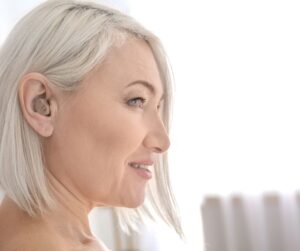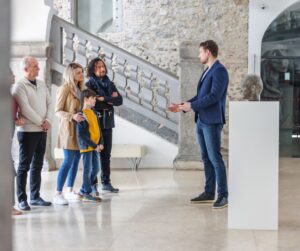Breaking the Boundaries of Hearing Impairment During Tours

Museums are largely thought of as a visual experience; however, there are significant auditory barriers to a fulfilling experience for hard of hearing (HoH) visitors, especially during tours.
Approximately 1 in 7 Americans have some degree of hearing loss. Among this population, 25% use hearing aids, yet still benefit from additional assistance to help them hear and communicate better.
Museums are organizations dedicated to education, enrichment, and community. To truly deliver on this front, it is crucial that museum tours and activities are accessible to ALL visitors, including those with hearing impairments.
Increasing museum accessibility may seem daunting for administration and staff, but implementing a hearing aid-compatible audio tour system is easy and boasts significant benefits, including improving the accessibility and overall experience of tours.
Accessibility for the Hard of Hearing
Hearing loss affects millions of Americans, and it is the third most common chronic health condition in older adults. Despite its prevalence, hearing impairments are an invisible disability, and as a result, accessibility for HoH individuals is often overlooked.
 It can be incredibly frustrating – and disappointing – for hearing impaired visitors when they visit a museum that has not considered their needs. Some tours may be in loud, crowded environments making it difficult to hear the guide. Conversely, tours in quiet environments where the guide is speaking softly present hearing challenges, as well.
It can be incredibly frustrating – and disappointing – for hearing impaired visitors when they visit a museum that has not considered their needs. Some tours may be in loud, crowded environments making it difficult to hear the guide. Conversely, tours in quiet environments where the guide is speaking softly present hearing challenges, as well.
Some guides may think that to accommodate HoH guests, they just need to speak louder, or even shout. But this can be uncomfortable for people with hearing impairments, especially if they wear hearing aids.
Without an enhanced hearing solution, many HoH visitors cannot fully participate in museum tours and activities.
Integration with Hearing Aids: How It Works
Among US adults who use hearing aids, 13% still experience difficulty hearing in some situations. A two-way communication device can provide the extra assistance needed for HoH visitors to clearly hear during tours.
The audio tour guide equipment is easy to use. A transceiver is worn on a lanyard around the tour guide’s neck accompanied by a microphone and headset system for hands-free communication. Guests wear the transceiver around their necks, accompanied by an earphone for enhanced hearing.
The system can be set up for two-way communication, allowing visitors to ask questions, or one-way communication only, transmitting from tour guide to guests.
What makes a tour audio system hearing aid compatible? The receiver must be able to interface with the telecoil in an individual’s hearing aid or cochlear implant. If a visitor has to remove their hearing aid to use the receiver, or if the system’s earbuds interfere with their personal hearing device, then it is not hearing aid compatible.
Guests with hearing aids can adjust the volume to a comfortable level at which they can clearly hear the guide.
Premier tour audio systems will have three features that promote accessibility and engagement for all users:
- Hearing aid and cochlear implant compatibility
- Wireless, portable, hands-free use
- Two-way communication option
Tripp Communication Systems offers a variety of audio tour guide systems with these distinct features in addition to being Americans with Disabilities Act (ADA) and International Building Code (IBC) compliant.
The Benefits of Inclusive Tours with Two-Way Communication Systems
Making tours more accessible doesn’t only help those with hearing impairments. It creates a better, more enriching experience for all visitors.
 Enhanced Communication Experience
Enhanced Communication Experience
- Improved hearing and understanding.
- Allows users to adjust sound levels to their comfort.
- Tour guides do not need to raise their voices or shout.
- Audio systems can be set up for two-way communication to allow guests to ask questions and talk with the tour guide.
- Minimizes background noise and distance-related challenges by transmitting the tour guide’s voice directly to the visitor’s earphones.
Empowerment and Inclusivity
- Promotes a more collaborative, community-driven experience.
- Two-way communication systems empower individuals with hearing loss to actively participate in tours and activities.
- Provides freedom of movement and the ability to explore without feeling left out or dependent on others for communication.
Two-way communication systems are user-friendly and can be used for a variety of museum experiences such as special exhibitions, docent-led tours, education programs, and special events hosted at the museum.
Creating Memorable Tours for Everyone
Museums that incorporate a tour guide audio system open their doors wider, providing a more memorable and enriching experience for a more diverse audience. It allows guests to fully immerse themselves in the experience and increases visitor satisfaction.
Read our case study that shows how visitors and staff benefitted from a TCS tour audio system at the Auburn Cord Duesenberg Automobile Museum in Auburn, Indiana.
Reach out to learn more about how you can promote clear hearing and accessibility with a two-way communication system. You can even try a free 30-day demo to find the solution that best fits your needs.
